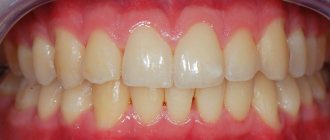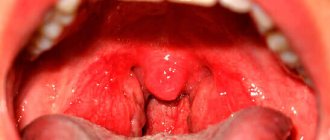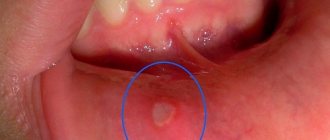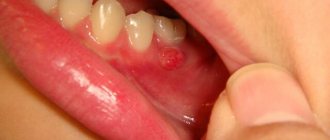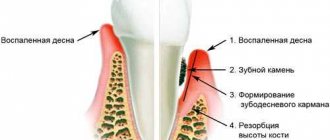April 17, 2020
Inflammation of the oral mucosa, such as stomatitis, rarely goes unnoticed. During the development of the disease, many unpleasant symptoms occur: pain and itching, redness and swelling of the mucous membrane, ulcers, an unpleasant yellow or gray coating in the mouth, weakness. Body temperature can also rise to high levels, especially if a child is sick, and this symptom causes serious concern for many parents. How many days does the temperature last for stomatitis? You will find information on this and many other questions on the topic in today’s article UltraSmile.ru.
Stomatitis – inflammation of the oral mucosa
Types of stomatitis: which of them can cause fever?
Doctors distinguish different types of stomatitis depending on the cause of the disease.
| Type of disease | Cause | Probability of temperature rise |
| Traumatic |
| Usually the temperature is normal, but if the mucous membrane is systematically injured, the risk of infection in the wound increases. Then, against the background of acute inflammation, the thermometer will begin to creep up |
| Candida | The disease is provoked by the Candida fungus, which actively multiplies with weak immunity or impaired metabolism, with poor oral care and long-term use of antibiotics. | The pathology is common in children and the elderly and is severe. Temperatures can rise to 39–40°C |
| Aphthous | Among the main reasons: viral infections, traumatic injuries to the mucous membrane, poor oral care | General malaise and an increase in temperature up to 38°C are observed already at the initial stage of development |
| Herpetic | The herpes virus lies dormant in the body of any person, but against the background of a sharp decrease in immunity, it is activated and affects the oral mucosa. This is the most common form of pathology in children, accounting for 80% of all1 clinical cases | More often a mild form is diagnosed, in which the disease begins with an increase to 37–37.5°C. In moderate and severe forms, the thermometer can rise to 39–40°C |
| Vesicular | A type of pathology, which is also called enterovirus. Its appearance is caused by various viruses. | Characterized by an acute2 febrile onset with hyperthermia and vomiting in the first 2–3 days. Symptoms similar to flu |
| Allergic | The mucous membrane can become inflamed due to the body’s individual reaction to medications, hygiene products (toothpaste, mouthwash), and food | Usually the temperature does not rise, but in rare cases, if an infection occurs, this is possible |
| Bacterial | They are provoked by staphylococci and streptococci, which are activated by weakened immunity, stress and hypothermia. | The thermometer can rise to 38–39°C. |
There are many forms and types of stomatitis. Each of them is treated with different medications. It is very difficult to independently determine what type of disease you or your child has, so at the first suspicion of pathology, do not delay contacting a doctor.
Temperature with stomatitis
An increase in body temperature is a protective reaction to a viral or bacterial infection that has entered the body.
On this topic
- Stomatitis
How to identify and treat ulcerative stomatitis
- Olga Alexandrovna Novikova
- August 14, 2020
A normal temperature is 36.6ºС; with some characteristics of the body – 37-37.5ºС.
Once pathogenic microorganisms enter the body, they begin to multiply and release waste products. Defense mechanisms are triggered and the temperature begins to rise. This is due to the fact that bacteria and viruses die when temperatures increase, and the production of natural interferon is also stimulated.
Most often, stomatitis is of a viral or bacterial type. Therefore, an increase in temperature is a sign that characterizes stomatitis.
How high can the temperature rise?
It all depends on the form, type, stage of the disease, as well as the degree of damage to the mucous membrane. If the inflammation is catarrhal and affects only the upper membranes of the mucosa, then the body temperature rarely rises above subfebrile limits.
What is low-grade fever? The Latin sub febris can literally be translated as “below the fever.” These indicators are from 37.1 to 38°C, the thermometer does not rise higher.
When the upper layers of the oral cavity are inflamed, there is usually a low-grade fever
If the stage is acute, and the process is complicated by the appearance of ulcers and ulcers, then the temperature during stomatitis increases, it rises to 40°C. How long it lasts depends on how soon treatment was started.
If stomatitis is in the chronic stage, then general health rarely worsens, and the thermometer does not rise above the usual 36.6–36.8°C.
About the forms of the disease and the degree of hyperthermia
There are three main types of stomatitis.
Aphthous form
The most common type of stomatitis, which perhaps everyone has encountered. During the pathogenic process, local inflammation of the mucous membranes (gums, tongue, cheeks, inner surface of the lips, throat) develops with the formation of painful aphthae - special ulcerative structures of a white or yellow hue. Aphthae are dense to the touch. Filled with liquid serous exudate. They appear singly or in groups. Dimensions do not exceed 1-8 mm. As a rule, the aphthous form is not characterized by an increase in body temperature for a long time. The disease occurs against the background of imaginary well-being. However, this only happens when the patient’s immunity copes with the disease and it does not enter the acute phase. If the defense system fails, the likelihood of hyperthermia is high. The thermometer readings rise to 38 degrees, the patient experiences pain, weakness, and drowsiness. These are symptoms of general intoxication.
Risk factors that can trigger hyperthermia
- weakened immunity: it is for this reason that stomatitis most often affects children, adolescents, the elderly, pregnant and lactating women, people with chronic diseases,
- infection: for example, the mucous membrane was first damaged by solid food, and then bacteria got into the wound,
- incorrect determination of the type and form of the disease, incorrectly selected medications and medicines: this often happens to those who try to be treated without the help of doctors,
- prolonged ignoring of the symptoms of pathology and the absence of any treatment.
If left untreated for a long time, hyperthermia may occur.
How many days can an unpleasant symptom last?
Let's talk about how long the temperature lasts for stomatitis in adults. Usually the high temperature lasts about 3 days. Low-grade fever can persist longer, for 7–10 days.
Read the article on the topic “9 important answers to questions about stomatitis in infants.”
How many days does a child have a fever with stomatitis? Children suffer from stomatitis more often than adults. Especially from candidal, bacterial and viral varieties. The course of the disease is usually acute, with all the accompanying symptoms (intoxication of the body, weakness, bad breath, loss of appetite). In children, a high temperature of 39–40°C is more often recorded, and it lasts up to 3–5 days. Low-grade fever (up to 38°C) may persist until the disease is cured. On average, treatment of pathology takes up to 10–14 days.
Children have a fever longer than adults
In some forms of stomatitis, for example herpetic, the temperature in children can independently drop to 37–37.5 ° C after the first rash appears. However, then it begins to grow again, becoming a harbinger of new rashes.
Stages of body temperature change
There are two classifications of temperature changes. The first classification reflects the stages of temperature according to thermometer readings, the second - the state of the body depending on temperature fluctuations. According to the first medical classification, body temperature is divided into the following stages:
- low - less than 35°C;
- normal - 35 - 37°C;
- subfebrile - 37 - 38°C;
- febrile - 38 - 39°C;
- pyretic - 39 - 41°C;
- hyperpyretic - more than 41°C.
According to the second classification, the following states of the human body are distinguished depending on temperature fluctuations:
- hypothermia - less than 35°C;
- norm - 35 - 37°C;
- hyperthermia - more than 37°C;
- fever.
How to get rid of anxiety symptoms
Is it worth lowering the temperature? If it does not rise above 38.5°C, then there is no need to bring it down, the body must fight on its own. Naturally, positive dynamics will be observed only if you have started treatment with specialized medications prescribed by a doctor. If you do not start treatment, then the temperature will not decrease, but, on the contrary, will begin to rise.
“I know that you can’t give antipyretics if the temperature is low, but I don’t look at the thermometer, but at the child’s condition. I think that if the baby is very capricious, eats and sleeps poorly, then it is better to take Nurofen. When my daughter was sick with stomatitis, she had weakness and malaise, but there was no high temperature, but I still always gave her Nurofen at night so that she could sleep peacefully and so that she wouldn’t be nervous!”
Kris, review from babyblog.ru
If the levels are high (39–40°C), then taking antipyretics is mandatory. After all, hyperthermia is dangerous because during it the body overheats and dehydrates, and various cells begin to break down. This can negatively affect the entire body, causing complications in the cardiovascular system, brain, liver and kidneys. In young children and infants, hyperthermia can cause seizures and even respiratory arrest.
If you have a high temperature, you should take an antipyretic
It is known that very high temperatures do not go down well and quickly rise again. Especially in children. To combat it effectively and safely, you can alternately give antipyretic drugs with different active substances. For example, Nurofen based on ibuprofen and Panadol with paracetamol. It is also important to provide fresh and cool air in the room where the sick person is. The sick person should drink a lot and stay in bed, sleep more. You need to avoid visiting public places.
If a small child is sick, then suppositories and suppositories “Efferalgan”, “Viburkol”, “Cefekon” are well suited to eliminate hyperthermia.
Remember that it is unacceptable to treat stomatitis only with antipyretics. Therapy must be comprehensive and agreed upon in advance with the doctor. The treatment course should include taking antibacterial, antiviral or antifungal agents, depending on the type of pathogen. Antiseptic treatment of the oral cavity should be carried out (for example, Miramistin). It is also necessary to follow a gentle diet and exclude spicy, salty, hot, and solid foods from the menu. All this is done to ensure that the infection does not spread further, and the mucous membrane heals faster.
Notice
: Undefined variable: post_id in
/home/c/ch75405/public_html/wp-content/themes/UltraSmile/single-item.php
on line
45 Notice
: Undefined variable: full in
/home/c/ch75405/public_html/wp-content /themes/UltraSmile/single-item.php
on line
46
Rate this article:
( 2 ratings, average: 5.00 out of 5)
prevention
- Drobotko L.N., Strakhova S.Yu. Acute stomatitis in children // Issues of modern pediatrics. – 2010.
- Churina E.N., Tseka Yu.S., Lavrentiev G.P. Enterovirus infection in children // Bulletin of medical Internet conferences. – 2020.
Consulting specialist
Belyaeva Olga Alexandrovna
Doctor rating: 9.8 out of 10 (4) Specialization: Dentist-therapist Experience: 10 years
How to bring down a high temperature of 38 and 39°C
Doctors do not advise lowering the temperature below 38°C inclusive: the disease has not yet reached a critical state, and the body is able to overcome the infection on its own. To reduce the temperature above 38°C, antipyretics are used.
In an adult
The following medications are prescribed for adults:
- Paracetamol is an antipyretic.
- Ibuprofen is an antipyretic and anti-inflammatory drug.
- Askofen is an antipyretic and analgesic.
- Nurofen - reduces fever, relieves pain and inflammation.
Like adults, doctors do not advise children to lower their temperature below 38°C. The exception is infants: fever has a bad effect on the baby's well-being, the child refuses to eat and sleeps poorly.
To lower the temperature in children, children's forms of antipyretic drugs are used:
- Paracetamol in the form of suppositories - for children from 2 months, the duration of the effect is 4-6 hours.
- Ibuprofen in the form of a suspension - for children from 3 months, the duration of the effect is 6-8 hours.
- Nise in the form of a suspension - for children over 2 years old, the duration of the effect is 4-5 hours.
Attention! The dosage of the drug is determined by the doctor. If the temperature cannot be brought down to 39°C or higher, you must urgently call an ambulance.
We invite you to read: What does an orthodontist do in dentistry?
Traditional medicine is used as a complement to drug treatment of stomatitis - they are aimed at improving the child’s well-being and accelerating the healing of mouth ulcers.
Folk remedies for stomatitis in children:
- To treat illness in infants, dissolve 1 tbsp. l. baking soda in 200 ml of water and wipe the oral cavity with the solution using a cotton swab 5-7 times a day. Before feeding, the mother's nipples must also be wiped with the solution.
- For the treatment of stomatitis in children over 1 year of age, infusions of medicinal herbs are used. Pour 1 tbsp. l. dried chamomile or calendula flowers with 1 glass of boiling water, let it brew for 1 hour. Wipe the oral cavity with warm infusion 3-4 times a day until the wounds completely disappear.
- From 2-3 years old, when the child learns to rinse his mouth, use egg yolk. Pour 1 egg yolk into a glass of warm (not hot!) boiled water and mix thoroughly. Use the solution to rinse your mouth and throat every day 3-4 times a day.
- From the age of 3, it is allowed to wipe wounds and ulcers in a child’s mouth with a peeled aloe leaf. The procedure is carried out 4-5 times a day.
- From 5-6 years of age, pure peach oil is used to wipe the affected areas of the oral mucosa. Apply a cotton swab to the ulcers 3 times a day.
Before using one or another folk remedy for the treatment of stomatitis, it is important to make sure that the child is not allergic to the components of the recipe.
It is impossible to say for sure how many days the child will continue to experience discomfort. The period of the disease is not precisely determined, because much depends on the state of the baby’s immunity and the form of stomatitis.
Estimated time frame:
- with a large number of wounds and high temperature, symptoms of stomatitis will be observed for at least 10 days;
- with a small lesion and a temperature of about 37 degrees, stomatitis will disappear in 3-4 days.
To prescribe treatment, the child must be shown to a pediatrician. If necessary, antipyretics are prescribed - Nurofen, Panadol, children's Paracetamol. The amount of medication will be determined based on the age and body weight of the baby.
If the temperature is above 39 degrees, and after taking medications there is no decrease, you should urgently consult a doctor. The baby may have seizures.
During illness, you should adhere to the following recommendations:
- Do not eat hard foods. If the child is small, then you can feed liquid, soft or pureed foods.
- Humidify the air in the children's room and ventilate the room.
- Give your baby something to drink as often as possible.
The high temperature must be lowered in cases where it exceeds 38 degrees. Thus, the body is given the opportunity to cope with the problem on its own. Considering that hyperemia can cause discomfort to babies, especially infants, they refuse to eat, which aggravates the situation.
To reduce the temperature, you can use a special form of Paracetamol or Ibuprofen. The drugs can quickly alleviate the child’s condition by lowering the temperature, eliminating pain and slowing down the development of inflammation. But, it should be remembered that in the treatment of stomatitis, antipyretics alone are not enough; it is necessary to use antiviral, antifungal or antibacterial drugs that can destroy the causative agent of the disease.
At high temperatures caused by stomatitis, you should be careful; if the hyperemia exceeds 39 degrees, it is necessary to take urgent action to eliminate it. If the antipyretic used does not give results, you need to call an ambulance rather than increase the dose of the drug.
In an adult
In children with central nervous system pathologies or weakened immune systems, it is necessary to control the increase in temperature, since even minor hyperemia can cause serious harm to the child.
Comments
Is my stamatitis contagious?
Olga (04/22/2020 at 02:18 pm) Reply to comment
- It all depends on what pathogen causes the disease. If it is viruses and bacteria, then yes, stomatitis is contagious. Only a doctor after an examination can tell whether the form of stomatitis you are suffering from is contagious.
Editorial staff of the portal UltraSmile.ru (04/26/2020 at 09:25) Reply to comment
We use chlorhexedine as an antiseptic and antipyretic for stomatitis. But the pain still remains. Is it possible for a child with stomatitis to smear irritated areas of the mucous membrane with gels like Kalgel as a pain reliever?
Irina (05/20/2020 at 08:45) Reply to comment
My grandmother often has stomatitis, which is very worrying. He cannot eat normally, his temperature is low and he feels unwell. This is probably due to age or immunity is no longer the same, my grandmother is already old. What can be done about this?
Lyubov B (05/20/2020 at 09:10) Reply to comment
Tell me, how dangerous is chronic stomatitis without a noticeable increase in temperature? And how to deal specifically with the chronic form?
Oleg (05/20/2020 at 09:38) Reply to comment
What if the temperature is normal, but the gums are red, there is pain and there are white dots on the roof of the mouth? Isn't this stomatitis? Is it possible to cure such manifestations on your own, without going to the dentist?
Ulyana (05/20/2020 at 09:55) Reply to comment
I get stomatitis quite often, I use various remedies, it seems to help, but it appears 3 or 4 times a year, and there is no fever. How can I get rid of it once and for all?
Victoria (05/20/2020 at 09:58) Reply to comment
If stomatitis is not treated (provided there is no fever), how quickly will it go away on its own? Is it possible to rinse your mouth with a solution of soda or hydrogen peroxide? Is this dangerous? And if you already had stomatitis once, does this mean that now it will appear with any weakening of the immune system?
Anna (05/20/2020 at 09:59) Reply to comment
According to my symptoms, I have stomatitis. I have been suffering from it in chronic form for a long time. There is no temperature. Is it possible to cure it on your own? Or you need to consult a doctor for advice.
Larisa (06/22/2020 at 07:35) Reply to comment
My sister's stomatitis always occurred without fever. But still, the disease is not pleasant. Please tell me, is there any way to cope with this disease at home?
Julia (06/22/2020 at 15:49) Reply to comment
My father began using dentures. Ulcers similar to stomatitis appeared in the oral cavity. Could stomatitis be caused by this?
Elizaveta (06/22/2020 at 15:57) Reply to comment
I also have a question. Is it possible to get rid of stomatitis once and for all? I turned to a specialist for help and fought this disease at home. Will this disease always bother me?
Irina (06/22/2020 at 16:02) Reply to comment
Write your comment Cancel reply
Symptoms and causes of increased body temperature
Low-grade fever of 37.0 - 37.5°C is usually considered normal, but is sometimes a sign of pathologies developing in the body. In most cases, a slight increase in body temperature is caused by the following factors:
- prolonged exposure to the sun;
- intense physical activity;
- bath procedures, taking a hot shower;
- cold, viral infection;
- exacerbation of chronic diseases;
- eating hot or spicy food.
Sometimes a rise in temperature to 37°C is provoked not by harmless factors, but by life-threatening diseases. Most often, low-grade fever is established for a long time in case of malignant tumors and early stages of tuberculosis. Therefore, even a slight increase in body temperature should not be treated negligently, and if you feel the slightest discomfort, you should go to the doctor.
Only a medical professional can determine whether a temperature of 37°C is normal for a particular person. In rare cases, doctors have the opportunity to examine amazing patients for whom 38°C is the normal temperature.
A febrile temperature of 37.5 - 38.0°C is a sure sign of the development of an inflammatory reaction in the body. The body of a sick person is deliberately heated to such a level in order to suppress the viability of pathogenic microorganisms in this way.
Therefore, lowering febrile temperature with medications is not recommended. The body needs to be given the opportunity to overcome the infection on its own, and to alleviate the condition, prevent dehydration and get rid of toxic substances, a sick person should drink a lot of warm water.
At a pyretic temperature of 39°C, there is no doubt that an acute inflammatory reaction is occurring in the body. Typically, fever is caused by pathogenic viruses and bacteria that actively multiply in tissues and organs. Less commonly, a significant increase in body temperature is observed with severe injuries and extensive burns.
Pyretic temperature is often accompanied by muscle cramps, so people prone to convulsive conditions must be extremely careful during inflammatory diseases. When the body heats up to 39°C, you must take antipyretic medications. It is not difficult to understand that a fever is starting, since the following symptoms are usually observed:
- malaise, weakness, powerlessness;
- pain in the joints of the limbs;
- weighting of muscles;
- migraine;
- chills;
- heart rhythm disturbance;
- loss of appetite;
- profuse sweating;
- drying of the skin and mucous membranes.
If hyperthermia reaches 40°C, seek immediate medical attention. The highest temperature that the human body can withstand is 42°C. If the body heats up higher, metabolic reactions in the brain are blocked, the functioning of all organs and systems stops, and the person dies.
The factor that caused the hyperpyretic temperature can only be determined by a medical specialist. But most often, fever is provoked by pathogenic bacteria, viruses, toxic substances, severe burns and frostbite.
You can increase your body temperature in different ways. If the cooling of the body is caused by severe pathologies, then it is impossible to do without medications. If the decrease in temperature is not associated with diseases, then it is not necessary to use pharmaceuticals; it is enough to warm your feet in hot water, sit with a heating pad, and dress warmly. It is also useful to drink hot herbal tea with honey in the evening.
Attention, TODAY only!
Body temperature is checked in different ways:
- Rectally - in the rectum.
- Orally - in the mouth.
- Under the arm.
- On the forehead - this uses infrared scanners to check the artery.
- In the ear - also with the help of scanners.
For each method, there are electronic thermometers specifically designed for each location. There is plenty to choose from. But there is also a problem: cheap (sometimes not very cheap) devices often lie or fail. Therefore, when choosing an electronic thermometer, do not skimp, be sure to read the reviews and check the mercury readings at least once.
The latter, by the way, is preferred by many. A maximum mercury thermometer (as a thermometer is correctly called) costs a penny and is quite accurate, which cannot be said about many electronic devices with “so-so” quality. However, it is dangerous because it is easy, and shards of glass and mercury vapor have not made anyone healthier.
No matter what kind of thermometer you use, read its instructions first.
After each use, it would be good to clean the thermometer: wash it, if possible, or wipe it with an antiseptic. Be careful if the thermometer is sensitive to moisture and may become damaged. It’s embarrassing to mention, but still, a thermometer for rectal measurements should not be used anywhere else.






